Tom's Hardware Verdict
Aside from too-aggressive local dimming, the Cooler Master GP2711 has no real flaws. It has a colorful and contrasty image with premium video processing that delivers smooth and responsive gaming. Highly Recommended.
Pros
- +
High native contrast and large color gamut
- +
Sharp and bright picture with high output
- +
Accurate color with selectable gamuts
- +
Premium video processing for smooth lag-free gameplay
- +
Solid build quality
- +
Excellent value
Cons
- -
Aggressive local dimming reduces HDR brightness and quality
Why you can trust Tom's Hardware
The quest for contrast in LCD panels has taken us down a few different roads. With edge backlighting, VA technology is the best bet with native contrast ratios around 3,000:1. But zone dimming is on another level entirely. First, we had exotic and expensive IPS panels with 256 zones. Mini LED has largely replaced those monitors with over 1,000 dimming zones and super bright images.
Mini LEDs have also come down significantly in price thanks to market saturation among the best gaming monitors. Cooler Master is getting in on this trend with its new Tempest GP2711. It’s a full-array local dimming VA panel with 576 zones and HDR output surpassing 1,500 nits. It’s capable of super high contrast, and it sports QHD resolution, a 165 Hz refresh rate, Adaptive-Sync and wide gamut color. And it’s hitting the shelves at $449. Let’s take a look.
Cooler Master Tempest GP2711 Specs
| Panel Type / Backlight | VA / Mini LED |
| Row 1 - Cell 0 | Quantum Dot Film |
| Row 2 - Cell 0 | 576 dimming zones |
| Screen Size / Aspect Ratio | 27 inches / 16:9 |
| Max Resolution and Refresh Rate | 2560x1440 @ 165 Hz |
| Row 5 - Cell 0 | FreeSync: 48-165 Hz |
| Row 6 - Cell 0 | G-Sync Compatible |
| Native Color Depth and Gamut | 8-bit / DCI-P3 |
| Row 8 - Cell 0 | HDR10, DisplayHDR 1000 |
| Response Time (GTG) | 4ms |
| Brightness (mfr) | 600 nits SDR |
| Row 11 - Cell 0 | 1,000 nits HDR |
| Contrast (mfr) | 3,000:1 |
| Speakers | 2x 2w |
| Video Inputs | 1x DisplayPort 1.4 |
| Row 15 - Cell 0 | 2x HDMI 2.0 |
| Row 16 - Cell 0 | 1x USB-C |
| Audio | 3.5mm headphone output |
| USB 3.0 | 1x up, 2x down |
| Power Consumption | 21.4w, brightness @ 200 nits |
| Panel Dimensions WxHxD w/base | 24.2 x 16.7-21 x 10.8 inches (615 x 424-533 x 274mm) |
| Panel Thickness | 2.5 inches (64mm) |
| Bezel Width | Top/sides: 0.3 inch (8mm) |
| Row 23 - Cell 0 | Bottom: 0.7 inch (19mm) |
| Weight | 14 pounds (6.4kg) |
| Warranty | 4 years |
Most of the Mini LED monitors I’ve reviewed use IPS parts, meaning just 1,000:1 native contrast. The VA panel in Cooler Master’s GP2711 delivers over 3,300:1 out of the box with super low black levels. A Quantum Dot film layer means a wide color gamut. I measured almost 94% coverage of DCI-P3. With local dimming turned on, contrast ratios go even higher, to the point where I couldn’t measure them. Peak brightness is very high, with over 600 nits available for SDR and 1,500 nits in HDR mode.
Accuracy is ensured by a calibration data sheet included with each GP2711. My sample measured up, though it benefitted from a few adjustments. It’s a rare monitor with selectable color gamuts with independent settings memories. That means I could calibrate a DCI-P3 and an sRGB mode, and switch freely between them. Not only is this a benefit for nit-picky videophiles like me, but it’s also handy for graphics pros who need accurate color for their daily work.
Of course, gaming is the primary focus, and to that end, the GP2711 provides a 165 Hz refresh rate, which is achieved without overclocking. Adaptive-Sync works on G-Sync and FreeSync platforms; however, the GP2711 has not been certified by Nvidia, but I found flawless G-Sync operation in my tests. It also includes four overdrive presets plus a dynamic mode that varies with frame rates and a user-tunable option. A backlight strobe works instead of Adaptive-Sync and offers three pulse width settings.
As part of the Tempest series, the GP2711 has a few extras like aiming points, timer and refresh rate counter. You also get KVM functions that bind USB ports to specific video inputs so multiple systems can share a single keyboard, mouse and monitor. Video inputs include DisplayPort 1.4, HDMI 2.0 and a USB-C, which can double as a charge port. The only thing missing is LED lighting. The GP2711 looks like a premium screen at a value-oriented price. Let’s see how it performs.
Assembly and Accessories
The GP2711 comes in a plain brown wrapper with no color or graphics on the box. Blocks of crumbly foam reveal the panel, upright and base in three parts. No tools are required for assembly. A small brick serves as the external power supply, and you get USB-A/B, DisplayPort and HDMI cables. There is no USB-C cable, but you do get a handy clip for the stand to keep the wiring tidy.
Get Tom's Hardware's best news and in-depth reviews, straight to your inbox.
Product 360
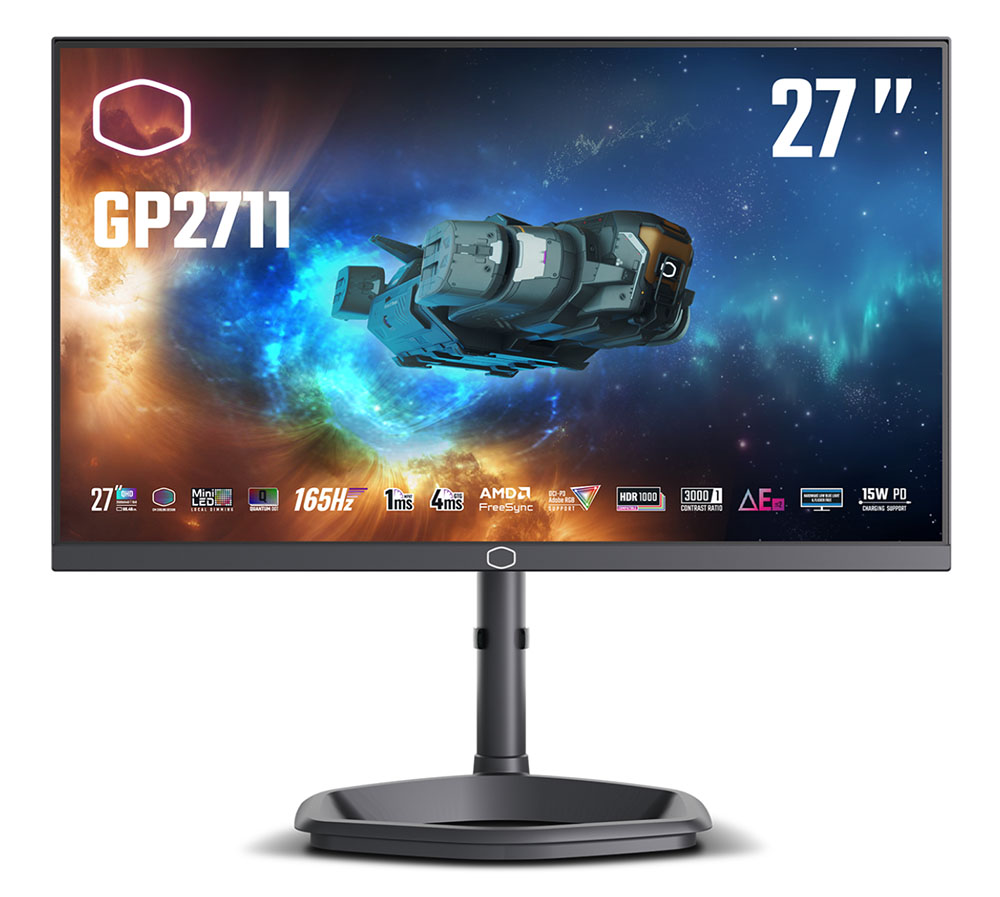
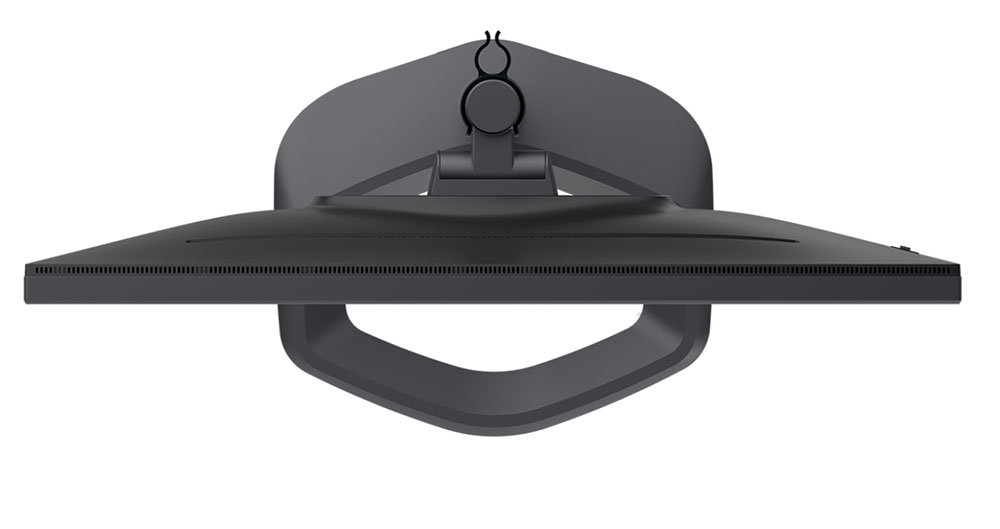
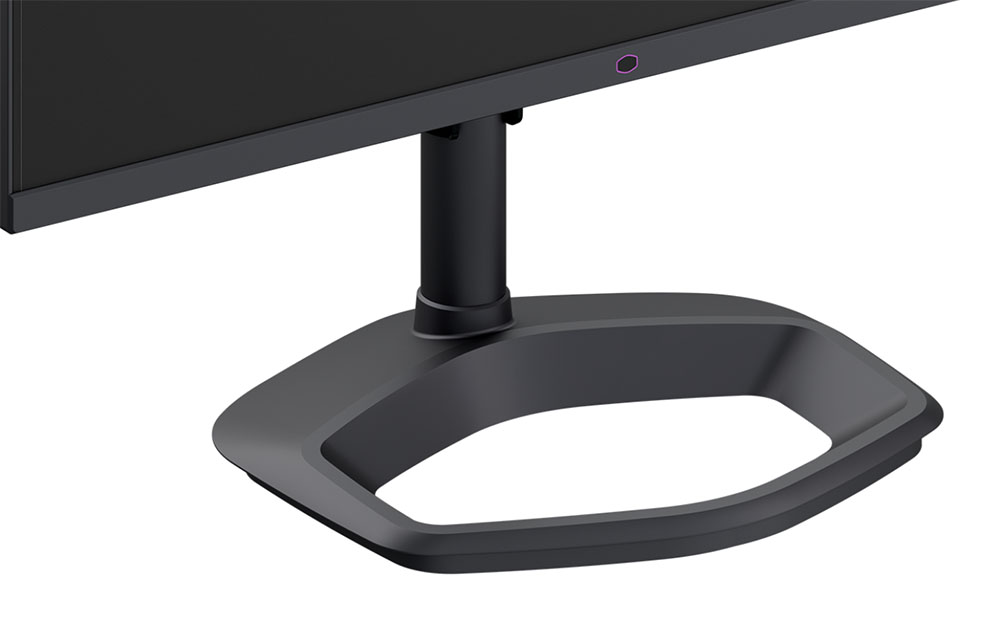
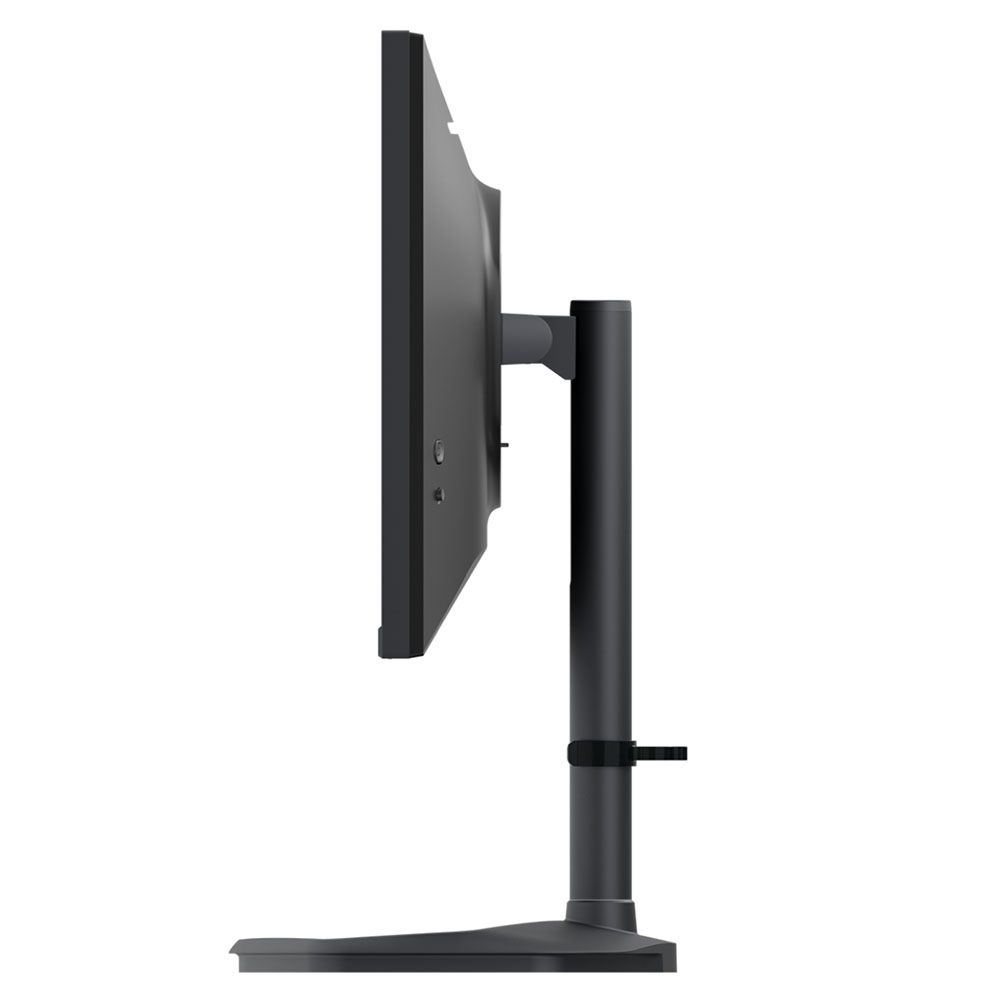

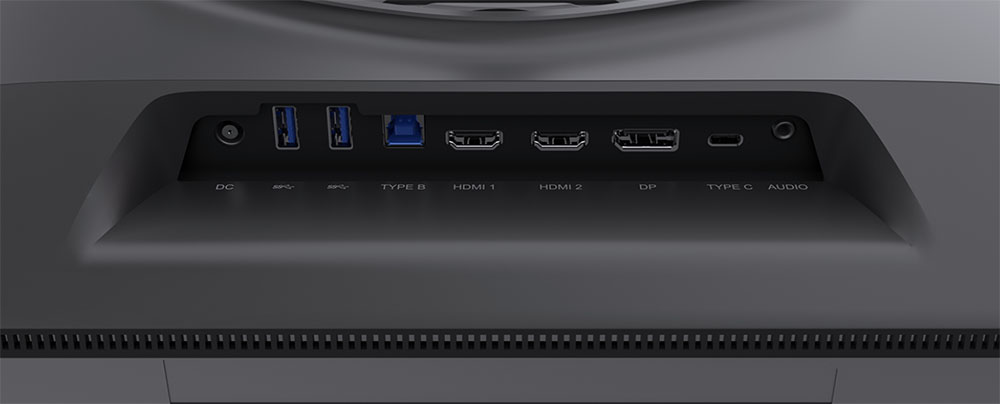
I recently reviewed the GM2711S, which is also a 27-inch QHD panel, so I expected the GP2711 to be similar in most respects. Though it has the same minimalist styling that Cooler Master is known for, it differs in many ways. The base is a metal ring shaped like the Cooler Master hexagon. The panel snaps onto the stand rather than requiring bolts. And the back has a little more to look at, with a louvered gray bit at the center.
The front’s only visible feature is a tiny Cooler Master hexagon in the center. The joystick and power button are behind the right side of the panel. A blue power LED projects onto the desktop with a soft glow. There is no additional LED lighting, so users wanting a flashy presentation must look elsewhere. A pair of built-in speakers generate two watts of power each and play with a clear sound focused on the upper midrange frequencies.
The side view shows a relatively slim panel with a deep base that provides rock-solid stability. Ergonomics include 5/20 degrees tilt, 90-degree portrait mode and a 4.3-inch height adjustment. There’s 15 degrees of swivel, which is barely anything. Movements are firm and sure, with no apparent wobble.
The jack panel is up and under the center with two HDMI 2.0, one DisplayPort 1.4 and a USB-C for video inputs. There are two downstream USBs and one upstream. The USB-C also carries peripheral functions and 15 watts of power. A 3.5mm audio jack supports headphones or powered speakers.
OSD Features
Pressing the GP2711’s joystick brings up a useful OSD with everything needed for picture adjustment and gaming. It’s divided into six sub-menus and includes signal information at the top.
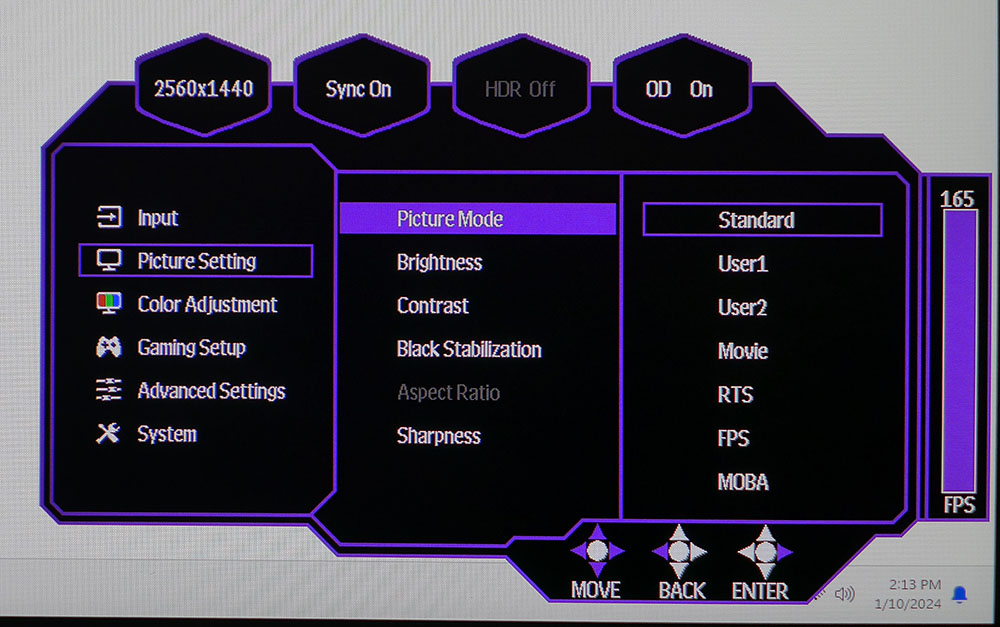
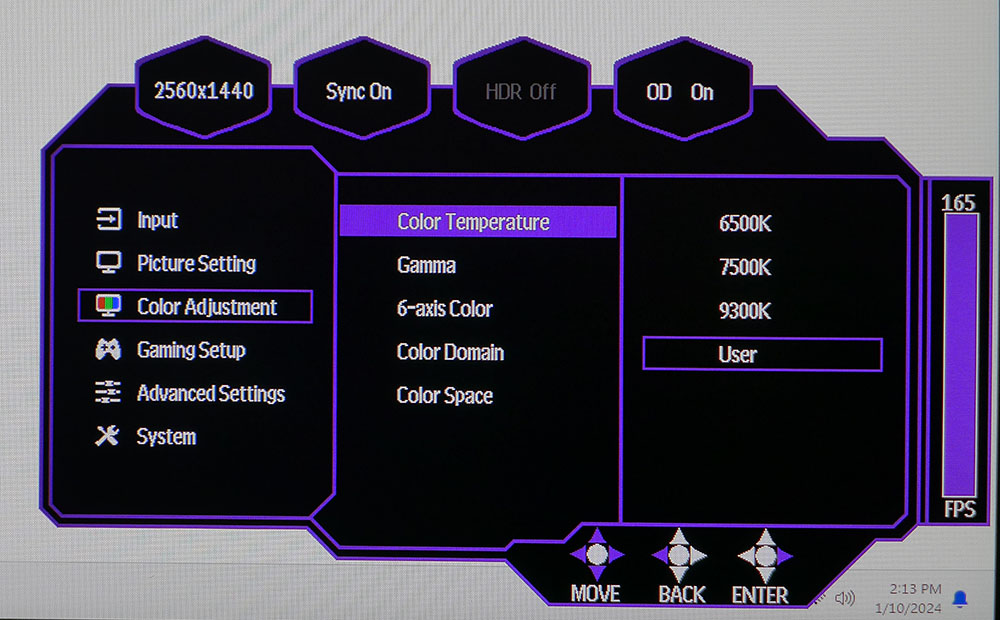
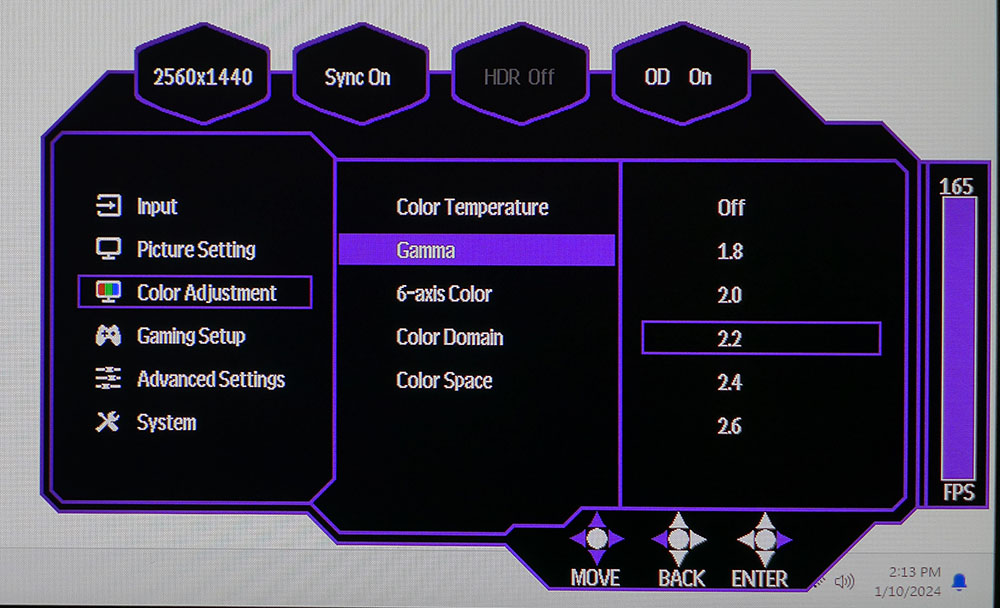
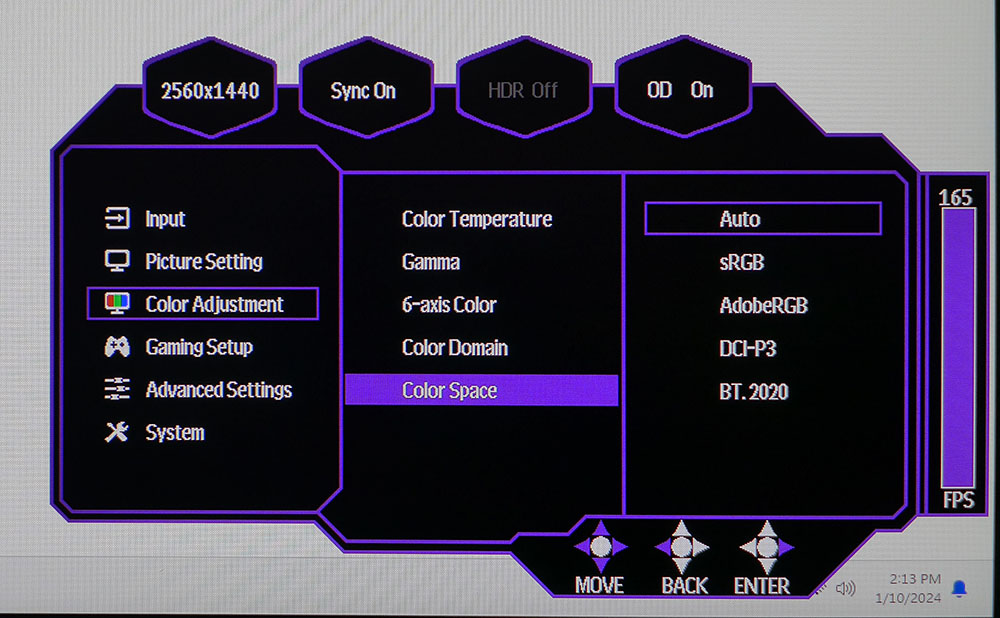
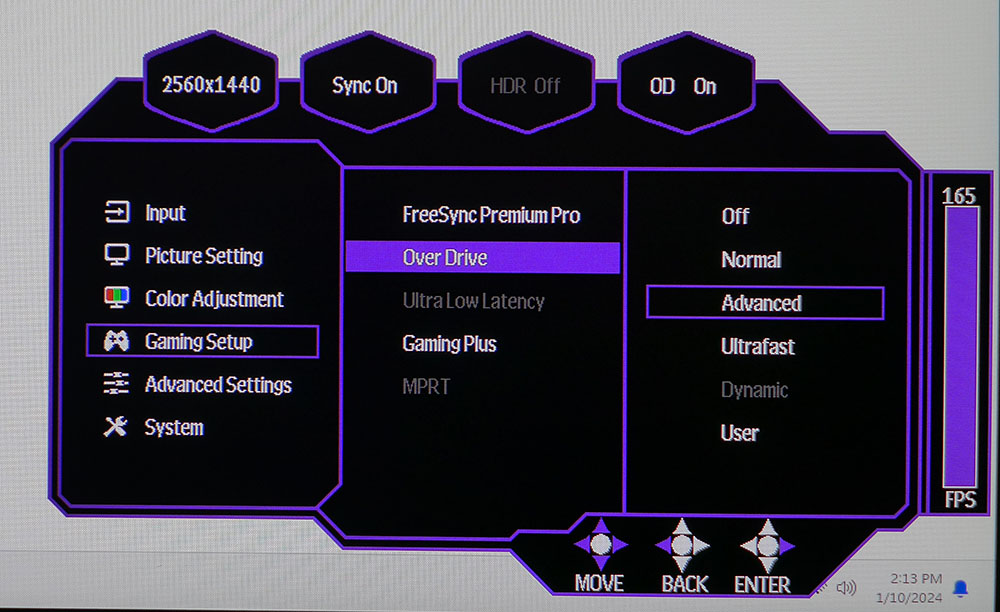
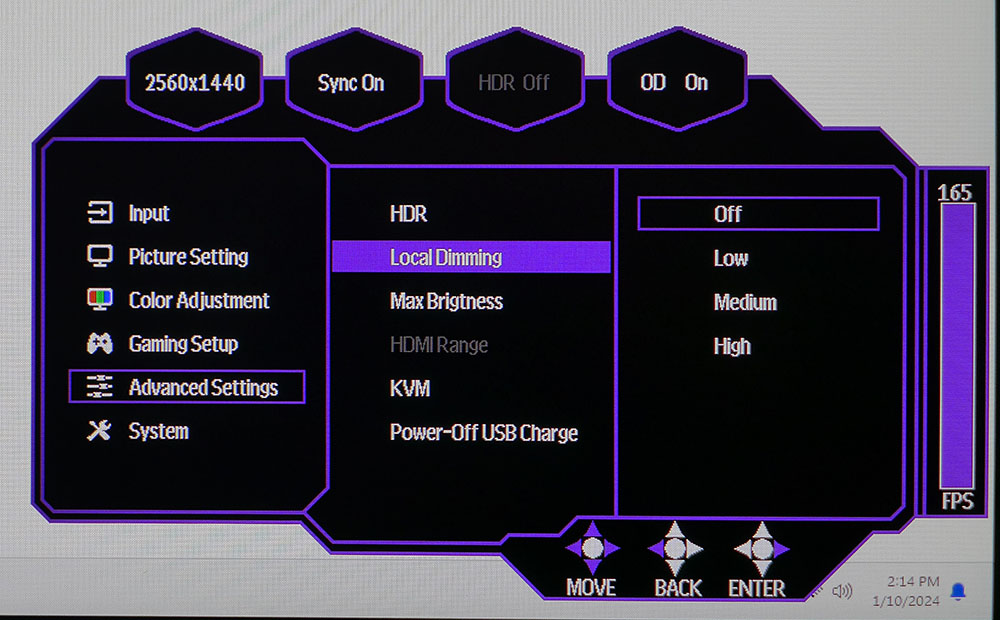
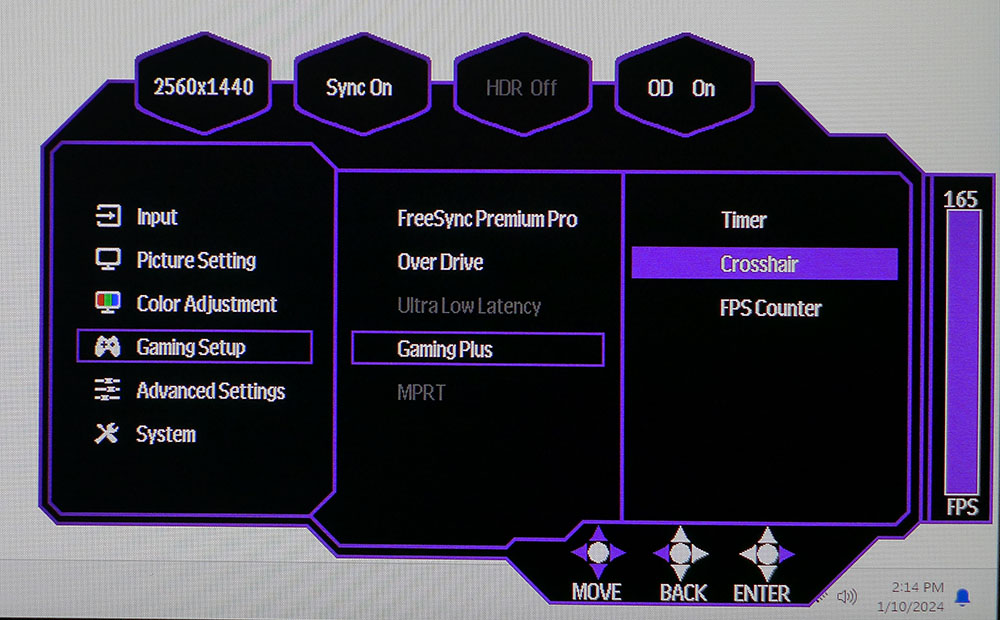
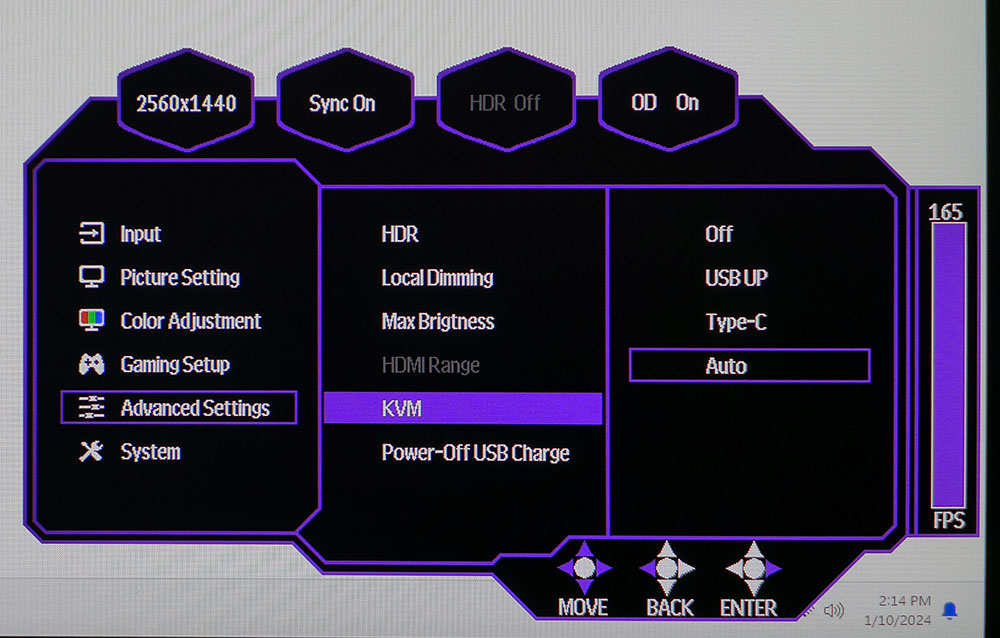
The GP2711 has nine task-specific picture modes. I found Standard to be the best one for SDR content. HDR signals add three more presets. Black Stabilization is useful for games with a lot of dark areas. You can turn up the slider if you have trouble seeing in the shadows.
Color Adjustment has three color temp presets plus a user mode with RGB gain and bias controls. I didn’t have to do much tweaking to get an accurate picture. Five gamma presets ensure proper luminance tracking. You also get color management and selectable color gamuts. The GP2711 includes presets for DCI-P3, Rec.2020, Adobe RGB and sRGB. I found they all measured very close to spec. They can be calibrated independently, which is very nice. I set up modes for DCI-P3 and sRGB and could switch freely between them.
Video processing receives equally positive attention with three fixed overdrive presets, a dynamic option and a user mode with fine control. I had no trouble eliminating motion blur without trail artifacts. The GP2711’s overdrive is superb. You can also engage a backlight strobe, MPRT, with three pulse width settings. Like all monitors with this feature, less blur means lower brightness. There is a little of the phasing artifact I usually see, but the dynamic overdrive option helps mitigate it. Gaming Plus is a suite of aids that include aiming points, timer and a frame rate counter.
The local dimming feature is quite aggressive and can be used for SDR and HDR. Even the lowest setting clips some highlight and shadow detail. It increases contrast, but I recommend using it sparingly. I observed that in HDR mode, turning it off doesn’t fully defeat it. I measured almost 6,000:1 contrast in my HDR tests with dimming off. More on that later. The Max Brightness option is a brightness limiter. When turned on, SDR brightness peaks at 296 nits. When off, it’s 633. I’ll talk about that more later as well. The KVM option switches between USB-B and USB-C as the hub for your peripherals. And you can use the USB-C port for charging up to 15 watts.
Cooler Master Tempest GP2711 Calibration Settings
The GP2711 has reasonably good out-of-box color but benefits from a few tweaks. By default, it renders its full native color gamut (94% of DCI-P3) for SDR content. You can switch to sRGB in the Color Adjustment menu if you wish. Each gamut mode can be independently calibrated. I set up DCI-P3 and sRGB modes for testing and used the RGB gain and bias sliders for precise accuracy. The gamuts measure to spec, which is nice. The GP2711 has pro-level adjustability, impressive for $449. Below are my SDR settings. I’ve included brightness values for max brightness on and off. If you turn it on, peak white is over 633 nits, and the minimum brightness is 135.
HDR signals activate three additional picture modes of which User is the best. They all have adjustable brightness, which is handy when you don’t want to be blinded by 1,500-nit highlights. That’s really bright!
| Picture Mode | Standard |
| Brightness 200 nits | 73 (14 w/Max Brightness On) |
| Brightness 120 nits | 36 |
| Brightness 100 nits | 26 |
| Brightness 80 nits | 15 |
| Brightness 50 nits | 0 |
| Contrast | 50 |
| Gamma | 2.2 |
| Color Temp User | P3 – Red 50, Green 50, Blue 48 |
| Row 9 - Cell 0 | sRGB – Red 48, Green 50, Blue 48 |
| Row 10 - Cell 0 | (Gains only, bias unchanged) |
Gaming and Hands-on
The first thing that struck me when gaming on the GP2711 was its incredibly sharp picture. Thanks to a lot of color and contrast, I could have been fooled into thinking it was Ultra HD. Of course, 109ppi is not exactly low pixel density. But in this size, you truly don’t need the extra pixels for a stunning image. The GP2711 produces some superb HDR.
I tried using the local dimming and came away unsatisfied. Though it deepened black levels, it also dimmed the picture overall. You’ll see later in my test notes that it significantly skews HDR luminance tracking. HDR looks best when served brightly, and leaving local dimming off is the way to achieve that. There is still plenty of contrast. I found that some dynamic trickery is still happening because HDR contrast is still almost 6,000:1.
For SDR, the local dimming is also very aggressive, but it enhances some content. I preferred the look of most YouTube videos with it set to Low. Medium and High clip too much detail. After a few hours of trial and error, I would request that Cooler Master set up its local dimming with more subtlety. The GP2711’s VA panel already provides a lot of dynamic range. It doesn’t need much help to be excellent.
Video processing was as good as the best 165 Hz monitors I’ve reviewed. The overdrive was very precise, with smooth and artifact-free motion resolution. The lag was low enough that I didn’t perceive it. My gaming skills are average at best, so I expect few players would complain. Perceived resolution was quite high, again due to the GP2711’s superb contrast and color saturation. The backlight strobe is completely usable as an alternative to Adaptive-Sync. Its phasing artifacts are minor, and I rarely noticed a problem when playing. But it’s only a little smoother than the overdrive alone, so after a few hours, I shut the strobe off and went back to G-Sync.
The GP2711’s color and contrast are well-suited for workday tasks. A 27-inch QHD monitor is a bread-and-butter display, so you can use this very capable gaming display for whatever needs you have. Its color accuracy is good enough for critical tasks and the switchable gamuts are super handy. Like most users, I gravitate to the wider gamut. Who doesn’t prefer a more colorful screen? But sometimes, I need sRGB when preparing graphics and here, it’s only a few clicks of the OSD joystick away.
Takeaway: The GP2711 is a superb gaming monitor with premium video processing and a stunningly bright image. I recommend leaving the local dimming off as there is plenty of native contrast available. And its operation is too aggressive and clips detail. Plus, it made HDR darker. I thoroughly enjoyed everything I did with it and would recommend it as a one-and-only display for those seeking gaming performance and value.
MORE: Best Gaming Monitors
MORE: How We Test PC Monitors
MORE: How to Buy a PC Monitor
Current page: Features and Specifications
Next Page Response, Input Lag, Viewing Angles and Uniformity
Christian Eberle is a Contributing Editor for Tom's Hardware US. He's a veteran reviewer of A/V equipment, specializing in monitors. Christian began his obsession with tech when he built his first PC in 1991, a 286 running DOS 3.0 at a blazing 12MHz. In 2006, he undertook training from the Imaging Science Foundation in video calibration and testing and thus started a passion for precise imaging that persists to this day. He is also a professional musician with a degree from the New England Conservatory as a classical bassoonist which he used to good effect as a performer with the West Point Army Band from 1987 to 2013. He enjoys watching movies and listening to high-end audio in his custom-built home theater and can be seen riding trails near his home on a race-ready ICE VTX recumbent trike. Christian enjoys the endless summer in Florida where he lives with his wife and Chihuahua and plays with orchestras around the state.
-
cknobman Forgive my ignorance but if local dimming ruins the picture what is the point, or advantage, of having the mini led's and over 500 dimming zones? (besides a brighter picture)Reply -
UnforcedERROR Reply
Fascinating question, because otherwise you're dealing with a completely standard LCD experience. The entire point of dimming zones is to give better contrast, especially when it comes to black levels. I read another review contrary to this, which also noted the brightness being diminished, that claimed local dimming was helpful with image quality.cknobman said:Forgive my ignorance but if local dimming ruins the picture what is the point, or advantage, of having the mini led's and over 500 dimming zones? (besides a brighter picture)
I find it strange to say not to use local dimming in a mini-LED monitor, personally. -
crimsonfilms I have theReply
I have the GP27U, the 4K version of this monitor. I love it. The dimming on that is excellent. As good as you gonna get for zone dimming panels. Mini LEDs still generally provide better brightness and to some extent color control than classic edge lit LEDs.cknobman said:Forgive my ignorance but if local dimming ruins the picture what is the point, or advantage, of having the mini led's and over 500 dimming zones? (besides a brighter picture) -
wingfinger I have sort of eliminated VA panels from my consideration. I have heard that there is a common issue with black smearing, caused by black parts of the image transitioning slower than the brighter parts.Reply
Most of the time I would value an artifact free image that is self-consistent. (I have heard that a few have ok-good transitions times, though)
For that reason, I also consider HDR, a nice to have because unless you have the budget for an OLED, there are times when you will want to turn it off. Right?
Games these days do seem to show no hesitation in having dark areas, though.
A lot of monitors are starting to sport a wide gamut. I would like to, also, use the monitor for some image editing or maybe content creation, but that would be SRGB or maybe Adobe. Right?
...
To be viable, the monitor has to support modes that correctly project the user input to the panels value set. Some don't have options, and some might not be accurate. Furthermore, the scaling would be crunching the numbers down -- more so the wider the native gamut. This for example, says a native 8 bit panel. A 10 bit panel could be better in this regard but might cost a bit more. -
UnforcedERROR Reply
The other version of this monitor is an IPS, and probably tracks closer to your expectation.wingfinger said:I have sort of eliminated VA panels from my consideration. I have heard that there is a common issue with black smearing, caused by black parts of the image transitioning slower than the brighter parts.
Most of the time I would value an artifact free image that is self-consistent. (I have heard that a few have ok-good transitions times, though)
For that reason, I also consider HDR, a nice to have because unless you have the budget for an OLED, there are times when you will want to turn it off. Right?
Games these days do seem to show no hesitation in having dark areas, though.
A lot of monitors are starting to sport a wide gamut. I would like to, also, use the monitor for some image editing or maybe content creation, but that would be SRGB or maybe Adobe. Right?
...
To be viable, the monitor has to support modes that correctly project the user input to the panels value set. Some don't have options, and some might not be accurate. Furthermore, the scaling would be crunching the numbers down -- more so the wider the native gamut. This for example, says a native 8 bit panel. A 10 bit panel could be better in this regard but might cost a bit more.
That said, it's rare to find a true 10-bit panel in this price range. Most things listed as 10-bit are really 8-bit + FRC. The difference is negligible, but some people are picky about that. -
-Fran- The CM miniLEDs are like the dark horse of the race. They are super good.Reply
I got one of them last Xmas because they were super cheap and the specs were super good. After receiving the first one, I bought 3 more, but unfortunately they only had 2 left, so I was only able to get 3 in total.
In any case, it's a really good monitor for the price. More so if you can find it with a nice discount.
Regards. -
wingfinger When I was looking at rtings a while back, I saw AOC Q27G3XMN had some similar qualities.Reply
But I felt it was a risk. It shows up as a notable mention for best gaming monitors list despite overall good scores. -
35below0 "The GP2711’s VA panel already provides a lot of dynamic range. It doesn’t need much help to be excellent."Reply
I guess the dimming doesn't add so much to this monitor, but that is hardly dissapointing.
Might be a useful setting to tweak. For someone. -
digitalgriffin There's a lack of understanding here by many.Reply
FIrst off, cooler master doesn't make their own panels. They pick one from a few mfgs like AU Optronix, Samsung, or LG. There's a few other players but they are the big ones.
Local dimming zones not only increase contrast but can also help with color accuracy. Let me explain.
Every LCD panel has back light bleed. That's the small percentage of light that shoots through even when the LCD cell is full closed. So let's take some really exaggerated numbers. For example let's say we have a 10% leak through. Let's say you wanted 50% red. Are you looking at 54% red, 10% Blue 10% green. That's because of wash through and black level minimums and calibration. You aren't looking at a true red but a semi washed out version.
To understand this look at the stars from a city. Most are washed out against a backlit sky from city lights. Now go to the country and look. Way different view..
So let's say we want to improve this. We turn down the backlight by half. You open red fully at 100% instead of 50% because we have 1/2 light. But the back light bleed through is half. This is where the improvement comes from.
The other issue is led light purity. Ideally to get a full color gamut you not only require low black levels, but also pure light colors. Red, Green, and Blue LEDs aren't truly mono chromatic like a laser. They give off a color distribution around their pure color. But again this creates color impurities. The only way to fix this is color filters. This is where tech like quantum dots come in. They really narrow the spectrum of light output. But quantum dots (QD) have longevity issues as they are typically organic, suffer burn in, and lamination issues. The failure rate of early QDs is huge.
Those 10 bit panels are a bit misleading also. There very few fast high quality true 10 bit panels and they cost a fortune. What most cheap 10 bit panels take an 8 bit panels and then alternate how often the panel blips open. I'm going to simplify some math here and say our panel is only capable of 200 distinct levels (8 bit is 256 but...math is complicated) Let's say you want 25.1% red. What you would get is a 50 one frame, 50 another frame, 50 a third frame, and then 51 the fourth. What's 201/(200 * 4 frames). ? That's right 25,1. However you werent looking at 25.1% every frame. Your eyes averaged it out. It's a cheap trick that has limitations. And this is a very common trick for really fast cheap TN panels, which use even worse 6 bit panels!
Finally the last issue is your environment. Unless you play in a dark dark room you won't benefit from most of this tech because your own screen reflects light impurities back into your eye. You ever look through a car window and see your own face reflected back? Your room is full of light polluting sources reflected by that screen.
And ignore that article about ratings.com about oleds being superior. Burn in on regular LED LCD is near impossible and easily reversible. What you do get is burn in of QD elements. Or you get liquid crystal memory. The later is fixable by quickly switching from closed to open for an hour or so.
For content masters you need to look at your target output. If it's film/TV, rec 2020. For all other consider DCI P3 or at the very least 100% sRGB coverage. -
razor512 Reply
There is one benefit to having a display like that and just setting it to a single static uniform backlight, while the luminance range gets decreased for HDR content (would effectively become HDR600 ), if the wider color gamut is maintained, then with good calibration, HDR gaming displays can work decently for video and photo work.cknobman said:Forgive my ignorance but if local dimming ruins the picture what is the point, or advantage, of having the mini led's and over 500 dimming zones? (besides a brighter picture)
